Honda Africa Twin Test | Day One
Honda CRF1000L Africa Twin TestRiding the Africa Twin | Day One
By Trevor Hedge
The Australian and NZ launch of Honda’s new CRF1000L Africa Twin kicked off on Monday with a 240km ride from Picton through to Hanmer Springs.
The first 40km was mainly commuting style riding on tarmac but the final 200km of the day was a beautiful run through the Awatare Valley, which really allowed me to get a great first impression of Honda’s, is it ever going to finally get here, entry to the more off-road side of the adventure-touring market.
Today I chose to ride the DCT version of the Africa Twin. This is the top of the range in what is a three-tier offering.
Trev on a Honda Africa Twin in NZ - Image by Harley Hamer
The base model, without ABS or traction control, sells for a surprisingly well priced $15,499. $16,999 gets you the ABS/TC model complete with handguards, bashplate, centre-stand and LED indicators while $17,999 gets you the burger with the lot, complete with Honda’s latest iteration of dual-clutch transmission technology which, in this application, is developed and tuned for both on and off-road performance.
I also rode on the standard Dunlop Trailmax D610 tyres. Most of the bikes on the launch have more serious off-road tyres, such as TKC70 or TKC80. I thought it more of a test of the machine to ride it with more limited grip, to get a better understanding of the dynamics and capabilities of the machine.
The bike I rode today also had the full kit of Honda hard luggage, large panniers and top-box.
Honda Africa Twin – Image by Trevor Hedge
Thus my mount was perhaps in worst case scenario mode for any serious off-road work. Where normally, if you wanted to have a crack in the dirt, the bike would be wearing something like Karoo 3 rubber, no luggage, and if you are technology averse, the base model machine with no ABS will be favoured by some, as while the rear ABS can be deactivated, the front ABS can’t be switched off.
The dirt today was not all that challenging in regards to extreme ascents or descents, but the surface was very loose and dusty, and thus on the standard road oriented rubber there was plenty of sliding around going on and more than a few front end tucks needed to be saved by a hefty stab of Alpinestars Toucan, my new favourite adventure boot, in to the ground.
I also let the DCT box do all the shifting itself, to test it’s mapping for off-road work. The DCT has three modes, normal, sport and manual, all three are easily selectable on the fly from the right bar. The auto modes can also be temporarily overridden by the use of the manual up-down shift paddles on the left bar.
On my report from today’s first day on the bike I will primarily concentrate on my impressions of the DCT.
While I understand that DCT technology is certainly the way of the future, early adopters in the automotive world have been severely burnt by expensive failures. The woes of Volkswagen Golf owners in particular are legendary, with $10,000 plus failures of their DCT gearboxes not uncommon. Anybody that would buy a secondhand DCT car or keep one out of warranty is a very brave person indeed.
That said, personally, if I was going to trust any manufacturer to get it right, then it would probably be Honda. In recent years, Big Red has been the most risk averse company when it comes to introducing new technology to the mainstream market. Honda also has a few years experience under their belt with DCT technology in their ATV product. And trust me, if anyone is going to break things, it is farmers. I have nothing against our hard working men and women on the land, but I have seen first hand the lack of mechanical sympathy they have for their motorcycles and ATV assets. Thus Honda’s experience in the ATV sector certainly does give me a fair bit of confidence that they might get this right.
What’s my opinion on how this latest Honda DCT stuff works?
It is bloody awesome.
Sure, the lack of a clutch lever and being able to bang down the gears to wash off speed in a hurry is a bit alarming at first, especially when it comes to panic braking as you arrive way too hot on the approach to a tricky off camber loose shale corner, complete with a 100-foot sheer drop waiting for you if you should get it wrong; instinct kicks in and you automatically reach for that clutch lever and the toes seek out a shifter; a slightly helpless feeling washes over you as realism dawns that neither are there to comfort you as you soil your pants…
But, for 99 per cent of riding scenarios, I quickly learned that the DCT in the Africa Twin is better than me.
Look, I am no Graham Jarvis, Chris Birch or Toby Price, but I have done plenty of adventure riding, including a 7000km off-road APC Rally. I have covered probably close to 200,000km on a variety of machine in this genre, including all the KTM Adventure bikes (I owned a 990 Adventure R), BMW GS machines in various capacities and generations, and also have plenty of experience on the old school more basic way of adventure touring from an Acerbis tanked XT600 Yamaha I once owned, through to the post ’97 generation of DR650 machines. Including one particular DR650 that I covered 54,000km on in 15 months, entered natural terrain motocross events on it, and rode it to those events on the same Pirelli MT21 rubber I would enter the event on, then ride home.
Thus, I am not new to this riding big bikes off-road caper. And with that level of experience under my belt, I still say that this DCT in the Africa Twin is, for the most part, better than me. For older riders starting to suffer from a bit of wear and tear on their body, and perhaps with some arthritis creeping into their hands, the DCT will be the best thing since electric start.
Of course, without a clutch lever I can’t pull the 462 monos per day I am well renowned for, it takes a crest in the track for me to get this bike up on one, but apart from that the only other times I think a conventional clutch might aid a rider of my very experienced, but certainly not Pro/Expert/Talented level of riding ability, is in the case of traversing perhaps a very rocky creek crossing, or needing to lift the front over a downed branch across an otherwise impassable track.
But, reality check here, this bike is not a 450, and the vast majority of riders interested in this machine are more likely to turn around and find another way to their next destination, rather than try and get a large adventure machine over a downed tree, or risk an incredibly expensive dunking in a deep river crossing. A friend of mine recently sucked water into the airbox of their 450 motocross machine and was up for an almost $5000 repair bill, and that’s on a single cylinder four-stroke motocross bike. The invoice for a full rebuild on a multi-cylinder adventure machine that swallowed a lung full of liquid does not bare thinking about.
Downshifting is almost imperceptible when braking lightly, but if up it for the rent and coming in hot then the system downshifts more aggressively. If rolling on the throttle gently to overtake after cruising the machine stays in top gear and uses the strong bottom end pull of the parallel twin. Twist a little harder and it will drop down to fifth, roll the throttle tube all the way to the stop and it will drop down as many gears as needed to get the machine up into the 6000rpm+ rev zone on the LCD tachometer. You feel it slot down each ratio in order, it doesn’t just go from 6th to 3rd for example, you feel the machine slot through each gate on the way down through the box.
If you are hard on the gas or feathering through a corner the machine knows this, and holds the gear you are in.
The switch for putting the machine in drive mode is below the start switch, another press selects sports mode.
From a standing start the machine feels entirely natural, likewise feet up slow speed manoeuvring is a doddle. Coming to a complete stop is also perfectly natural and fuss free. When parking on an incline there is a lever on the left bar that acts as a parking brake. If the sidestand is down the machine will not go into gear. Thus far, it has not made a mistake.
I am keen later this week to try a snotty loose more technical ascent to really see how it would go in the bush, for those potential owners that like their adventures a little more extreme. It’s been so competent thus far that the thought of attacking something more challenging has me more excited than filled with trepidation.
Honda Australia originally envisaged that the take up rate of the DCT option on the Africa Twin would be around 20 per cent. Early confirmed orders, of which there are already more than 100, indicate that this split is way off the mark, and that already more than 30 per cent of their first customers for the Africa Twin are wanting to buy a DCT equipped bike. After word gets out just how good this box is, I think that number may increase markedly.
I would love to add more but I have to get back on the trail. Feel free to use social media or the comments section below to ask questions that I will endeavour to answer over the next few days. I would love to have more time right now to dig into the technical nitty gritty of the DCT box and expand on numerous other areas of the machine but time is pressing. This promotional video from Honda shows a bit more about the DCT. I will check in again tomorrow after my second day of what will be four days on the Africa Twin, riding down New Zealand’s South Island.
Honda Africa Twin Test | Day Two
Honda CRF1000L Africa Twin TestYesterday’s first 240km introduction to Honda’s new Africa Twin, which I covered here on Tuesday, was backed up today by day two of our four-day adventure traversing New Zealand’s spectacular South Island.
Today’s 300km ride got underway from Hamner Springs and took us through the Lees Valley to Christchurch. The route today was around 50/50 road and off-road. The long off-road section again featuring a very loose surface but today was much tigher in nature, with countless tight switchback turns and hairpin bends, complete with sheer drops off the side to keep you on your toes. There was also one reasonably sized river crossing, nothing too extreme, but it was quite rocky and a fair degree of caution needed to be exercised.
I also again chose the DCT machine fitted with the road rubber and full luggage. The dirt section today on the stock rubber was hard work and required full concentration, as any momentary lapse was going to hurt. I did keep it together but must admit that my brain was pretty tired from the concentration required today and I was glad to cruise into Christchurch at the end of the day.
Yesterday I concentrated on explaining the merits of the DCT system. I continue to be incredibly impressed, but today did find one particular situation where I would have liked a conventional clutch. This was when turning around on very loose off camber gravel, where obviously the road tyres fitted to the bike had no purchase.
Normally in this situation I would have the clutch take-up at friction point and the driveline loaded up on the rear brake and then controlled the bike with the clutch more than the throttle while riding the rear brake as I made the tight and tricky turn, I missed not being able to do this with the drivetrain not loaded up against the brake, and thus felt a bit uncomfortable and put my feet down as I did the turn, not something I normally would have done in this situation.
But that’s my only complaint, I still think I am going to very much miss the DCT bike when I swap it for a machine with a conventional gearbox, which I will probably do tomorrow, but will certainly look forward to getting on a bike with some off-road rubber! An interesting point of note while we are on the subject of tyres is that the Africa Twin does not run tubeless tyres and, unlike most of the competition, it’s spoked rims are not suitable for a tubeless set-up. The grey and red variants of the bike have black rims while the predominantly white tri-colour scheme of my machine for this past two days has gold rims.
So 500km done and dusted so far on the DCT bike with standard tyres and full complement of Honda hard luggage. I’m tired, must be getting old, but bloody impressed.
The ergonomics of the machine feel great, the mirrors are some of the best in motorcycling, the seat is supportive and nicely shaped.
The pegs look to be too short but I have yet to have a foot slip off a peg, and the rubber inserts are removable. Where my knees bend below the upward curve of the tank there is still plenty of room above my knee, suggesting that riders with long legs are still going to find this bike quite comfortable.
The small windscreen works well enough but does not appear to be adjustable. I have experienced no buffeting thus far and the Honda branded luggage has not been too much of an impost.
Braking power and control is proving excellent. The Africa Twin runs large 310mm discs and Nissin radial four-piston calipers mount to the fully adjustable forks. The ABS system is proving unobtrusive and up to the task. Off-road the rear ABS can be disengaged to allow the bike to be drifted into a turn but while the front ABS can’t be disengaged, it has so far proved well mapped enough to not cause me to run on while off-road. Like all ABS systems deep corrugations under braking are not dealt with all that well, but that is the only situation where the ABS can struggle a little.
That is unfortunately all I have time for today. Internet coverage may be problematic this evening as we get up around the highest navigable trail in New Zealand’s South Island but I will endeavour to fill you in more about the handing and engine delivery of the Africa Twin as our four-day adventure continues.
Riding the Africa Twin | Day Three
The first half of the 450km section was mainly on tarmac, but the latter half was an enjoyable drifting run on dirt roads.
This third day of the launch I chose a conventional gearbox Africa Twin, shod with TKC80 off-road rubber.
After the past two days on a stock tyred DCT bike, complete with full hard luggage outfit, it was a revelation to get on a bike with off-road grip, and without the added impost of luggage.
The result was laugh in my helmet moments on the more open dirt roads. Back end of the Africa Twin stepped out sideways long before the corner and power-sliding all the way through long sweepers. The surface offered very little grip but was much more predictable than the previous days which allowed for some pretty loose action.
A few runs across a fun river crossing were also included and the DCT machines once again held their heads high. The DCT bikes were also tested up and down some reasonable off-road gradients and again came through the tests well.
One could say that the DCT machines are somewhat reminiscent of what can be experienced on enduro bikes fitted with Rekluse auto-clutches. These have been gaining popularity amongst the hard enduro experts and weekend warriors, making the machine virtually impossible to stall and working well on both two-stroke and four-stroke off-road machines.
Another modification a lot of serious 250/450 enduro riders are doing to their bikes is to fit a left-hand operated rear brake lever, at the same time as they install the Rekluse clutch. The DCT models of the Africa Twin actually already have this hardware in place as a supplementary caliper is fitted to the DCT bikes to act as a parking brake, which is operated from a brake lever on the left bar. I imagine it would not take too much work to turn this into an operative rear brake lever for use on the fly backing into turns, adding yet more amenity to those that find such things an attractive proposition. I have a fused right ankle so this is something I would probably investigate doing if taking a DCT Africa Twin home for good.
One of the first questions I asked the assembled Honda personnel was ‘what if you have a tumble and bash up the right hand switch block that allows you to put the DCT machine into drive mode?’
Apparently, there is a fail safe in the DCT system that if problems occur it will stay in one gear to allow you to get home. There is also a back-up foot lever available if you want to manually shift with your foot, rather than the paddles on the left switch block. It was still unclear if the optional foot shifter allows the neutral mode to be engaged, or whether the switch block is still needed to put the machine in gear. I have sent some questions to Honda who are chasing these matters up with Japan so I can bring you a definitive answer at a later date.
The 998cc parallel twin has a grunty persona, and feels significantly more powerful than its claimed 94hp. Given enough head it can break through the 200km/h barrier.
Maximum power arrives at 7500rpm while the 98Nm of torque peaks 1500rpm earlier. The delivery is very linear, but thankfully does not feel flat.
I have not really enjoyed too many parallel twin engines. In many cases they can be quite devoid of character and don’t really give me all that much enjoyment. I am very, very glad to report that the Africa Twin engine is far from mundane and boring. This was my greatest fear ahead of getting on this bike, I really hoped Honda had not dumbed it down too far in the quest for user friendliness, making the engine about as exciting as a diesel water pump in the process.
Thankfully it does have an enjoyable gait and even sounds pretty good. Even though it is a completely different engine configuration from the long discontinued VTR1000, the Africa Twin does have a similar feel to that very popular v-twin. Not the same, of course, but it is a little similar.
The Africa Twin has significantly more grunt and a more enjoyable character than BMW’s F 800 GS, but is certainly no match for the prodigious output of the latest water-cooled R 1200 GS, which in its latest iteration is a truly superb power-plant.
The Africa Twin is also not quite as grunty as KTM’s downsized 1050 Adventure, and as such is of course not remotely comparable to the hedonistic 150 pony firepower of the 1190 Adventure. The 1050 KTM though has less capable suspension than its bigger sibling, and the brakes are not quite as good as found on the 1190 either. As such, the Africa Twin has a better suspension and braking package than the 1050, and the chassis is at least as good as the 1190, perhaps even a little better.
The Africa Twin doesn’t have the rev-happy, kid with A.D.D. style character of Triumph’s 800cc triple but the Honda is less tiresome as a result, making it easier to put the power down to the ground. The claimed maximum power of the Triumph is about the same, but Honda claim a lot more torque, as you would expect from 200cc more and one less cylinder, and this certainly feels the case in the real world. The Honda is also much smoother and again, I think the suspension and braking package better than the Triumph, significantly better than the base model Tiger for sure, but also marginally better than the Tiger XC. While the Honda engine is much more fun than I had expected, and does certainly have a lot more torquey grunt than the Tiger 800, the Brit triple-cylinder engine certainly does offer a lot of character and zip.
Incorporating the incredibly compact Unicam cylinder head design from Honda’s highly successful CRF450R and CRF250R motocross machines, the Africa Twin engine has lots of smart design elements aimed at keeping the power-plant as compact as possible. The cast camshaft is located in a similar fashion to that seen on the Fireblade and operates 36.5mm intake valves and 31mm exhaust valves.
A pair of spark plugs fire each cylinder, so four plugs in all, across a phased firing order while resin coated 92mm pistons slide through a 75.1mm stroke.
The Africa Twin engine also sports a semi-dry sump design which, in-part, has helped Honda to give the Africa Twin an outstanding 250mm of ground clearance, while still managing to retain a reasonable seat height of either 850 or 870mm on the adjustable standard seat, or lower again with the optional low seat. The machine is very slim between the knees which makes the seat height more manageable.
A 270-degree crankshaft helps with the character while balance shafts help to keep things smooth while pulling double duty in driving the ancillaries. A parallel twin is also, by design, naturally much more amenable to exhaust and induction routing than a v-twin engine. It means that no rear header needs to be routed near the shock and under your loins, meaning that both the shock, and the rider, remain more comfortable.
I really have to give Honda some credit for their suspension work on the Africa Twin. I haven’t had that many nice things to say about the quality of the rear shocks fitted to some of their non-sportsbike machinery in recent years.
The Showa shock suspending the Africa Twin through a 220mm stroke is fully-adjustable and even visually looks like a serious unit, a 46mm cylinder is flanked by an impressively sized remote reservoir. We gave the bikes a pretty hard time in some fairly hot conditions and the shock never seemed to run out of damping control. That suggests the Africa Twin might still perform quite well two-up with luggage. Preload is set by a handwheel while rebound and compression is set by screwdriver.
Up front 45mm Showa cartridge forks also proved excellent. With 230mm of travel and a leading axle design the whole mass centralisation ethos has continued right through to the forks and the quite handsomely finished yokes.
Despite the very reasonable $15,499 price of entry, for a base machine with no DCT/ABS or Traction control, it is extremely pleasing to see that Honda does not seem to have cut corners in regards to the suspension and braking package on the Africa Twin. I hope this is a sign of more promising things to come from Big Red.
In our next instalment we will talk further about the new Africa Twin as we traverse some of the highest public roads in New Zealand before winding our way down to Queenstown, where we complete our 1300km epic on Honda’s new adventure machine. Meanwhile, check out our day one report, and day two report if you have not perused them before coming through to this third instalment.


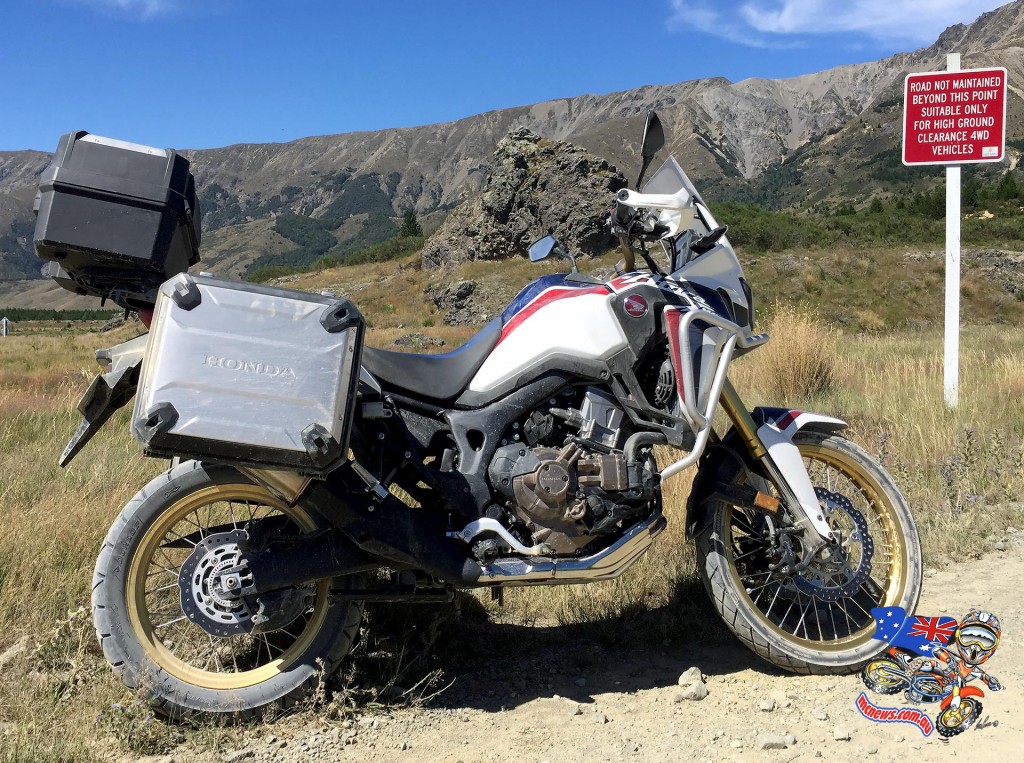
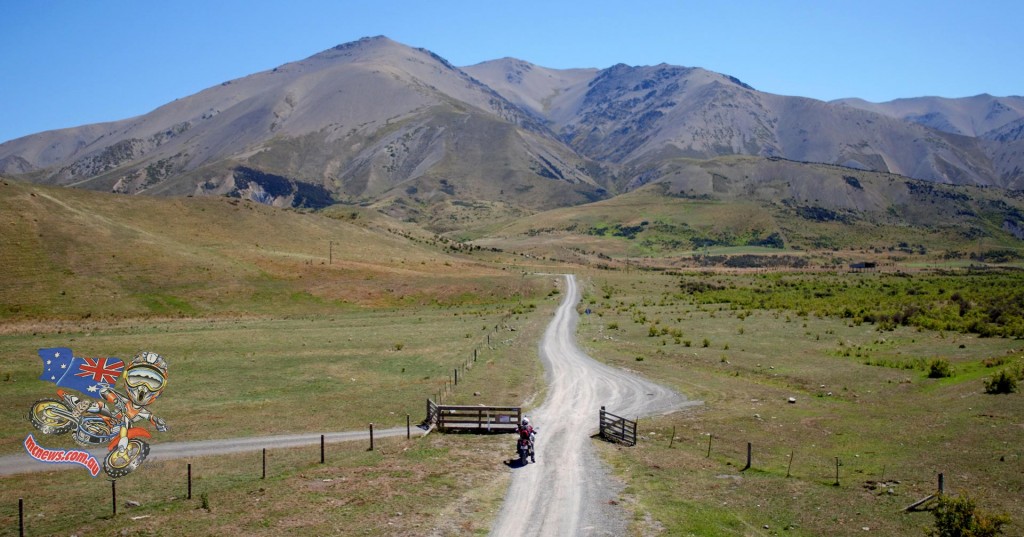

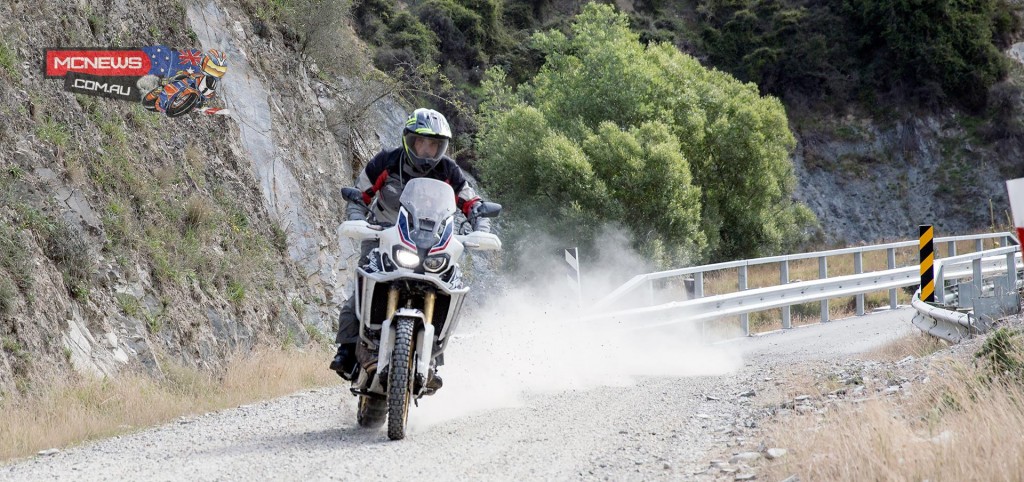
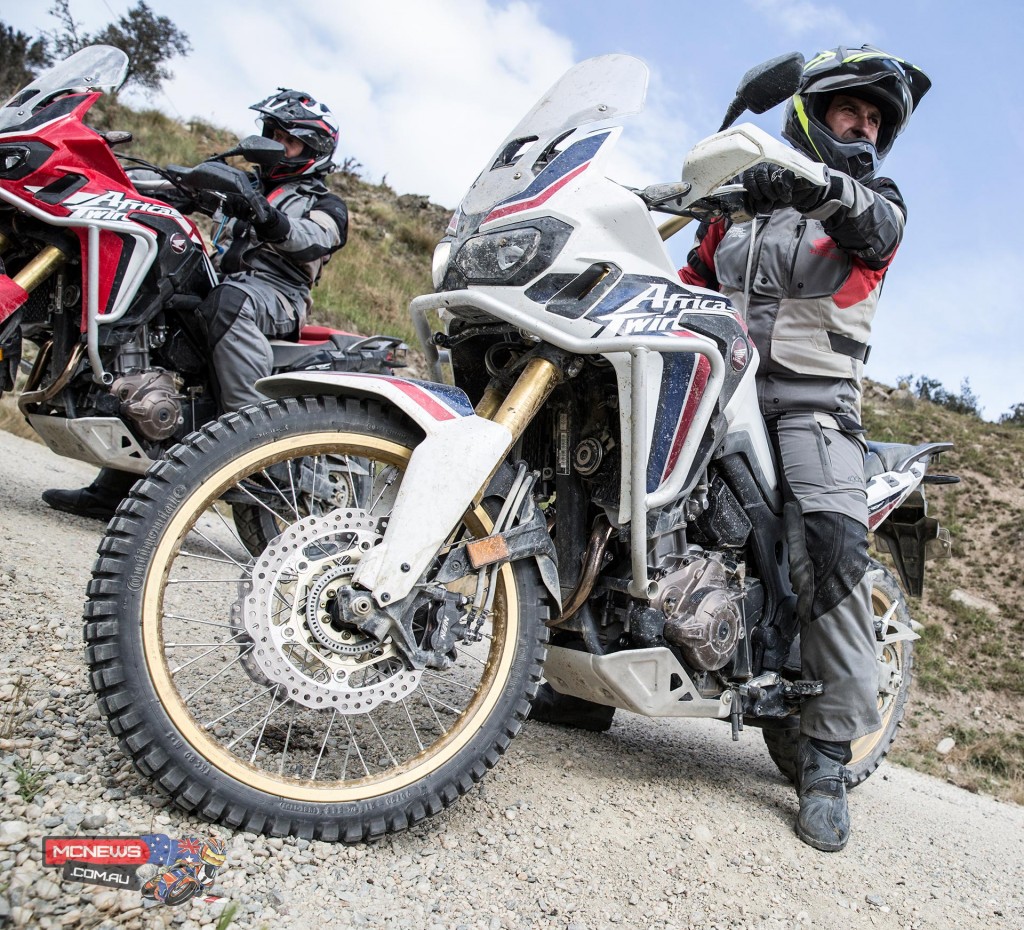
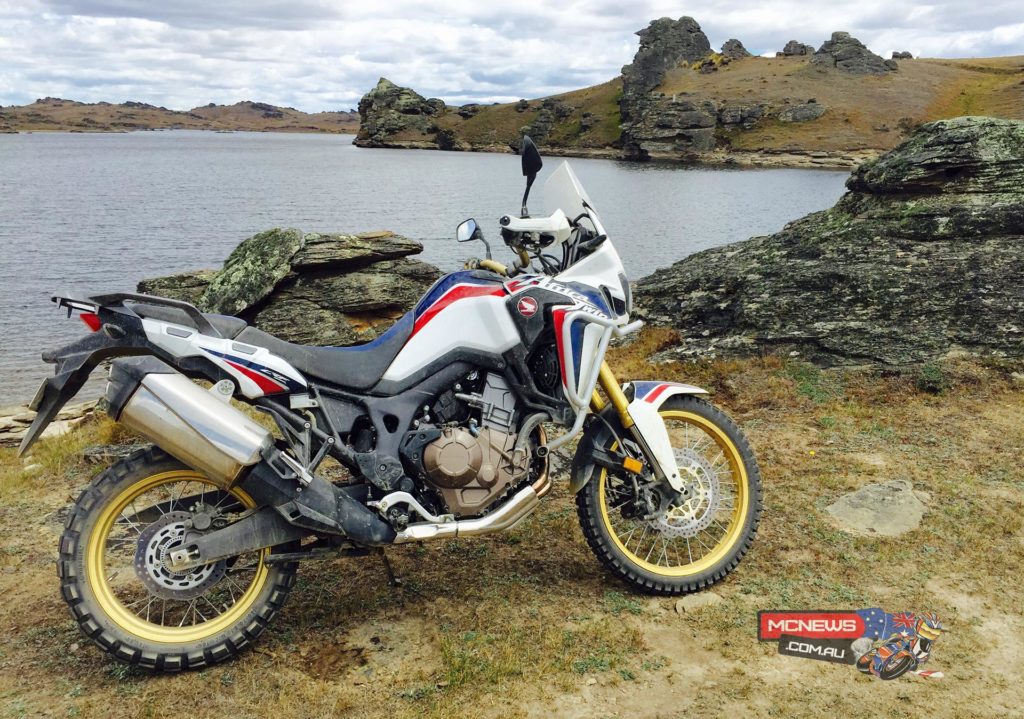
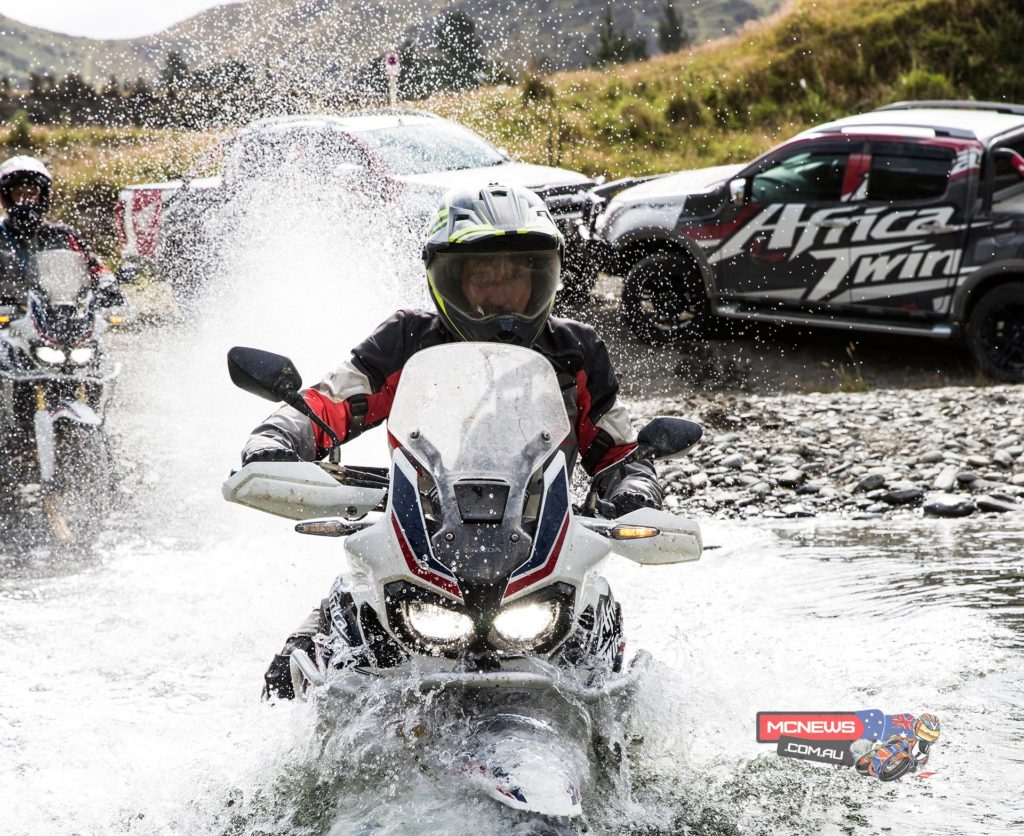
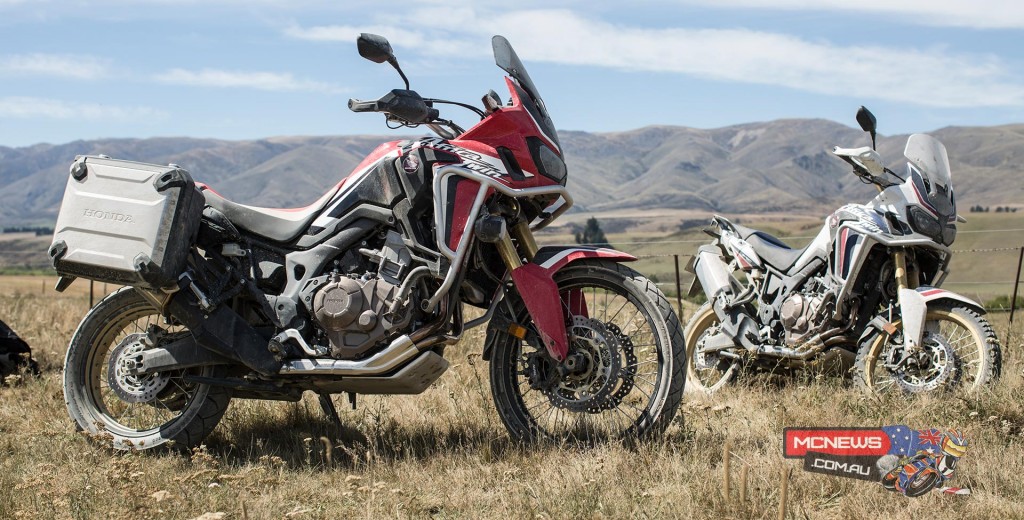
Aucun commentaire:
Enregistrer un commentaire